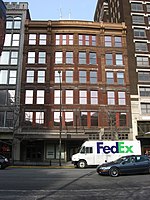Marott's Shoes Building
Chicago school architecture in IndianaCommercial buildings completed in 1900Commercial buildings in IndianapolisCommercial buildings on the National Register of Historic Places in IndianaIndianapolis stubs ... and 5 more
Individually listed contributing properties to historic districts on the National Register in IndianaMarion County, Indiana Registered Historic Place stubsNRHP infobox with nocatNational Register of Historic Places in IndianapolisTudor Revival architecture in Indiana

Marott's Shoes Building is a historic commercial building located at Indianapolis, Indiana. It was built in 1899–1900, and is a seven-story, four-bay, rectangular, Tudor Revival style building faced in white terra cotta. It has large Chicago style window openings on the upper floors. It features Tudor arched windows on the top floor and a crenellated parapet. It is located next to the Lombard Building.: 2–3 It was listed on the National Register of Historic Places in 1983. It is located in the Washington Street-Monument Circle Historic District.
Excerpt from the Wikipedia article Marott's Shoes Building (License: CC BY-SA 3.0, Authors, Images).Marott's Shoes Building
East Washington Street, Indianapolis
Geographical coordinates (GPS) Address Nearby Places Show on map
Geographical coordinates (GPS)
| Latitude | Longitude |
|---|---|
| N 39.7675 ° | E -86.1575 ° |
Address
East Washington Street 14
46204 Indianapolis
Indiana, United States
Open on Google Maps










